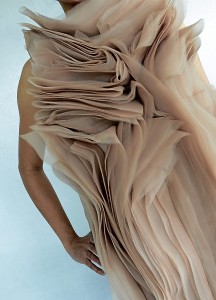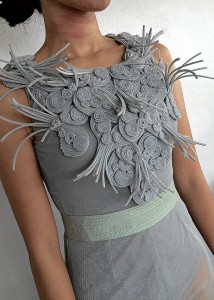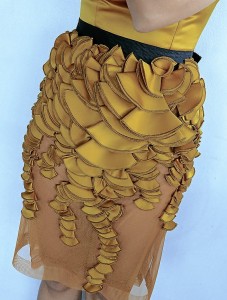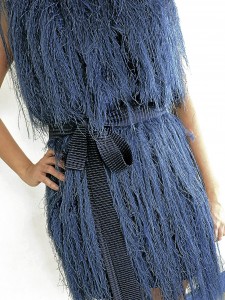 A new breed of Filipino fashion designers is finding ways to work around an age-old issue—lack of fabrics—that has nagged a generation of designers before them.
A new breed of Filipino fashion designers is finding ways to work around an age-old issue—lack of fabrics—that has nagged a generation of designers before them.
It’s still an issue, yes, but younger designers no longer look at the inadequacy of locally available materials as too much of a setback. The talent of Filipino fashion designers, says one, is the ability to come up with something even from limited resources.
“It’s just about how you execute it out of the box,” says Chris Diaz, 34, who has been making clothes for a little over 10 years.
Diaz and his contemporaries make do with what’s there, with a bit of tweaking: They distress, burn, pleat, laser-cut, fray, strip or excoriate, in order to come up with new textures and thus transform otherwise ordinary fabrics into something special and uniquely their own.
“We can make something even from overruns,” Diaz says. “It’s only a matter of manipulating your material.”
Three-dimensional clothes
“It’s about vision,” says Joel Escober, 36, who, until recently, shared an atelier with Diaz. “It’s true that at the end of the day the only thing you’ll see is piña, jusi, organza, crepe, satin,  tulle, chiffon. It’s how you use them. I want to create three-dimensional clothes, so I put spiked feather-effect fabrics. I can buy feathers, but I’d rather make my own feather element and combine it with other elements to complement the fabric exactly.”
tulle, chiffon. It’s how you use them. I want to create three-dimensional clothes, so I put spiked feather-effect fabrics. I can buy feathers, but I’d rather make my own feather element and combine it with other elements to complement the fabric exactly.”
When Diaz competed in a design tilt in Malaysia in 2006 (and won), he learned that Malaysian designers only had access to formal fabrics—silk chiffons and beaded laces.
“That automatically limits you, creativity-wise,” he points out. “For us, we can make something from overruns from Epza in Cavite, even if they’re just knits… If you have the drive, you will experiment.”
Kristel Yulo, who graduated magna cum laude from New York’s Fashion Institute of Technology, similarly likes to experiment with materials.
In one ’50s-style dress, she painstakingly wove threads into one of two fabrics before plaiting them together to come up with a basket-weave effect. In place of beadwork, she also hand-pleated strips of ironed silk chiffon then layered them on the bodice of a dress, creating a lattice-like pattern.
She has swatches of various fabric manipulation techniques, which she uses on the pretty bridal dresses she is becoming known for.
Sourcing materials
 “You just learn how to start from school, but practicing is really what’s important,” says Yulo, 31. “That’s why I no longer enrolled in another course because I was learning more doing things hands-on. School is a very clinical, controlled environment. It’s also different scale-wise if you have a staff doing it for you altogether at the same time. It’s a faster learning experience. You can’t do that in school where you’re the only one doing it all. As a designer, you want something that you put together, not something ready-made or fabricated.”
“You just learn how to start from school, but practicing is really what’s important,” says Yulo, 31. “That’s why I no longer enrolled in another course because I was learning more doing things hands-on. School is a very clinical, controlled environment. It’s also different scale-wise if you have a staff doing it for you altogether at the same time. It’s a faster learning experience. You can’t do that in school where you’re the only one doing it all. As a designer, you want something that you put together, not something ready-made or fabricated.”
It’s not always easy, “but you can train people,” says Escober, who set up his own business 12 years ago. “I do the sampling. I control; if it’s too heavy, remove. There’s balancing and layering. You have to encourage your staff to excel.”
Like her contemporaries, Yulo acknowledges the inadequacy of local materials. And just like them, she doesn’t see this as an issue.
“If you want printed silk, you can’t get that,” she says. “If you need winter fabrics, it’s even harder. But I know that there are suppliers abroad; if you really need something specific, you can order. I guess it’s also because of my experience abroad; I know where to source things. That’s what I’m looking at for my own wedding in early 2014.”
Design leanings
If Escober is making a name owing to his signature frou-frou style, his design leanings weren’t always this way.
The young man studied fashion design and dressmaking at Madonna Fashion School straight out of high school. After his two-year course, he began working for his sister who had set up a garment export business. Then he got jobs at various labels like Sari-Sari, as well as the now-defunct Milkwear, the breeding ground of avant-garde designers like Ignacio Loyola, Mich Dulce, Norman Noriega, Tina Daniac and Jerome Salaya Ang, all of whom were his contemporaries.
“At the time, I wanted certain silhouettes, but I still can’t express my voice as an artist,” says Escober, who, like Diaz, designs a line for Myth boutique in Greenbelt 5.
“The edgy kind was the trend in my time. But I knew that I wanted to do something different. More Valentino, Elie Saab—clean, sophisticated, feminine and soft.”
It was when he won the “Revival of the Terno” tilt held at the Metropolitan Museum of Manila in 2003 that Escober caught the eye of Randy Ortiz, who, as creative director of Myth, would later tap the young man to join the boutique’s roster of designers. Escober’s line is one of Myth’s top sellers.
Fanciful looks
Tweaking materials is imperative for Escober’s fanciful looks. He likes to pile on textures. In one fringe-y design, he had his staff fray fabrics to create long, soft strands. He could’ve easily purchased a ready-made fringe material, but he insists that “that’s the difference between Zara and a designer dress. It’s a different treatment. The feel is different if it’s handmade. Yes, it costs more and I don’t always like to make things difficult, but some things can’t be done shortcut.”
He likes ornamentation, but it doesn’t mean Escober can’t sew. One might argue that designers like him resort to embellishment to hide the fact that they can’t sew.
“Although I’m a fan of their work, I’m not into cutting like Ivar (Aseron) or Joey (Samson),” says Escober. “I’m more into whimsical effects. My magic wand is in ornamentation. This is my repertoire… Some like the work of Noel (Crisostomo) because it’s impeccable and practical. Some like mine even if it’s hard to dry-clean, because they love frou-frou.”
Technical limitations
Unlike Yulo or Escober, however, Diaz admits to his technical limitations. He didn’t attend a fashion or dressmaking school; he has a certificate in interior design. He, however, trained at a factory creating embroidery for European and Japanese couture houses.
“I still don’t know how to sew. I have people do that. I’m limited in the technical aspect,” Diaz says. Since he and Escober parted ways, he has had to outsource the sewing of his clothes—seamstresses create the shell, he personally puts the embellishments. He makes his own appliqués.
“My exposure was in the decoration. That’s what excites me. It was just my drive. Fabric manipulation is a good way to make a very interesting dress without it becoming tacky, if you want to design something without bling and beadwork… Lace, if you buy per yard, the pattern is repetitive. You have to take it apart para yung gapang niya softer.”
Diaz’s brand of ornamentation has a market: rich ladies who don’t like beadwork because they want their estate jewels to stand out. Filipinas take to his decorative, romantic styles, a sensibility he believes to have been passed on by the Spanish: The more, the merrier.
Balance and proportion
Diaz adds that decorating a dress is in itself a skill. “Scaling is a skill. Too much texture will add to the width. You need to know balance. It’s strategic. If you want to play with proportion and distribution, the dress becomes more interesting and modern. There’s crucial formula.”
As an example, he cites the swirls of fabric (called tourbillonner) he uses on many of his recent brides, influenced by Chelsea Clinton’s wedding dress by Vera Wang. Clinton’s frothy skirt had swirls and swirls of bias-cut fabric strips. “Consider the yardage used, but it looked so light,” he notes.
Still, he’s aware of his disadvantage in a highly competitive trade, so Diaz plans to enroll in a fashion school next year.
 “Training is vital to a long-term career as a tool,” says Yulo, who also attended Slim’s after she graduated from De La Salle University. “Everyone who wants to be a designer has an imagination, but translating and executing it, you need training for that, from paper to product.”
“Training is vital to a long-term career as a tool,” says Yulo, who also attended Slim’s after she graduated from De La Salle University. “Everyone who wants to be a designer has an imagination, but translating and executing it, you need training for that, from paper to product.”
She interned at W magazine just so she could study up close the clothes from all the design houses.
Yulo does everything in-house. “If you get people who could work well with you, it’s not hard. I want to be in control. If you outsource, and you don’t like it, you go back and forth. The sampling is harder. I used to make shoes before going to design school. If I wanted something, it took days because I couldn’t do it myself. Now the R&D is faster.”
She adds, “Design isn’t completely art, it’s also commerce. You have to consider what the client wants from you. I consider it from a girl’s point of view. Even if it’s harder to do, it’s satisfying. I like doing it. It adds value to the design.”









































